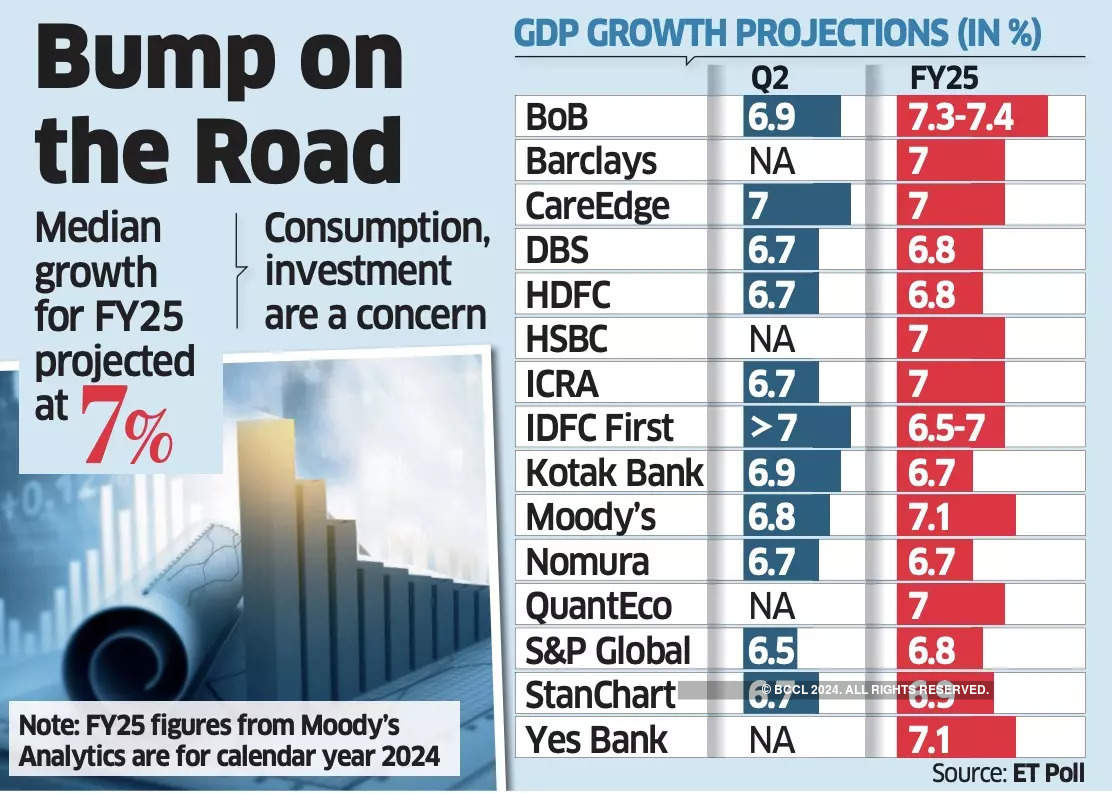According to an ET survey of 10 economists, India’s economic growth is likely to be subdued in the July-September period, mainly due to a slowdown in consumption and investment amid heavy monsoon rains in several parts of the country. The poll’s average estimate for second-quarter gross domestic product (GDP) growth is 6.8% annualized, with estimates ranging from 6.5% to 7%.
The economy grew by a robust 8.1% in the corresponding period last year, and by 6.7% in the first quarter of this fiscal year. The Reserve Bank of India revised its growth outlook for the September quarter to 7%, up from 7.2% at its monetary policy meeting last month. Official figures will be announced on November 29.
“Diesel and electricity consumption are lower in the second quarter, partly due to heavy rains in August and September,” said Sakshi Gupta, chief economist at HDFC Bank.
Global slump a factor
“Moreover, sales of passenger cars and two-wheelers have also slowed down,” said HDFC Bank’s Gupta. Aditi Nayar, chief economist at ratings agency ICRA, estimated GDP growth for the September quarter at 6.7% and gross value added (GVA) at around 6.4% due to heavy rains that affected mining, electricity sector and retail compared to the original publication. April-June. The first corporate results for the quarter also indicate weakness in the economy. An ETIG analysis of the results of 175 companies showed that turnover and net profit increased by 7.2% and 2.5% respectively. Sales growth was the slowest in five quarters, while profit growth was at a six-quarter low.

External triggers
The global slowdown could also have affected growth, noted Upasna Bhardwaj, chief economist at Kotak Mahindra Bank. She remains cautiously optimistic about rural demand, but expects urban demand to show some weakness. Rising bilateral tensions with Canada, the escalating conflict in West Asia and the ongoing war between Russia and Ukraine have affected exports from India. Goods exports fell 3.7% in the quarter from a year earlier, an analysis of monthly data showed. Several sectors of the domestic economy were also weak. “Tepid growth in consumer goods production, unsecured loan growth and core imports will contribute to the slowdown,” said Radhika Rao, senior economist at DBS Bank. Both fixed asset investment and exports could lose momentum due to the ongoing normalization of public infrastructure investment and weaker external demand, said Hanna Luchnikava-Schorsch, head of Asia-Pacific economics at S&P Global Market Intelligence .
Consumption & inflation
HSBC’s Manufacturing and Services Purchasing Managers Index (PMI) for September indicated slowing momentum. Manufacturing in India’s core sector has been volatile and low, growing 6.1% in July, falling 1.6% in August and growing 2% in September. Food inflation will remain a critical factor impacting consumer sentiment and spending in the coming quarters, said Rajani Sinha, chief economist at CareEdge Ratings. “Weak demand in China and the resulting flood of goods into the Indian market have put a damper on domestic private investment,” she said.
Annual forecast unchanged
However, economists surveyed believe the slowdown in the second quarter will not hinder overall growth for the year. Projections indicate that the economy will grow between 6.8% and 7.1% in FY25. “If consumption and investment do not pick up in the second quarter, estimates may be revised downwards, but growth is expected to remain above 7% for FY25,” said Madan Sabnavis, chief economist at the Bank of Baroda. There will be double-digit growth in consumption and 8-10% growth in investments, with a revival in non-premium and rural consumption, he said. Gaura Sengupta, economist at IDFC First Bank, noted that while growth rates are lower than FY24, they are still robust. “Factors that supported FY24, such as a slowdown in the GDP deflator, contraction in subsidy expenditure and a decline in input costs, which led to an increase in profits for listed companies, will be missing in FY25,” she said. RBI has maintained its growth forecast at 7.2% for FY25. Further recovery in private sector activity – especially household expenditure – on the back of improvement in rural incomes following a good monsoon and additional social support provided in the budget for 2025 has been announced will be important drivers of growth, Luchnikava-Schorsch said. Both the World Bank and the International Monetary Fund have forecast 7% growth for India in FY25.













